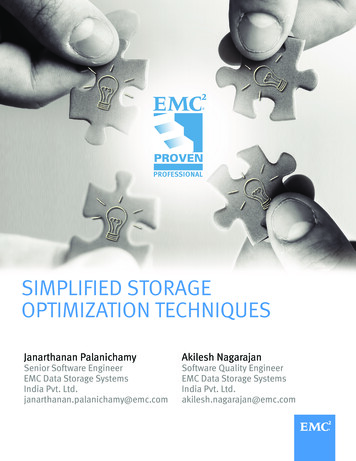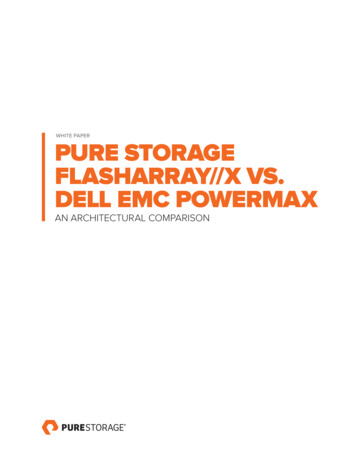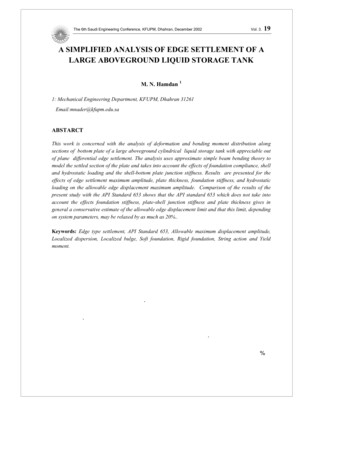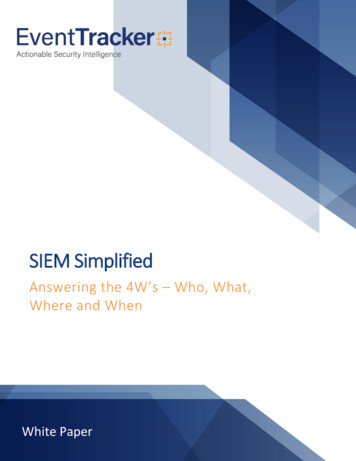
Transcription
SIMPLIFIED STORAGEOPTIMIZATION TECHNIQUESJanarthanan PalanichamySenior Software EngineerEMC Data Storage SystemsIndia Pvt. Ltd.janarthanan.palanichamy@emc.comAkilesh NagarajanSoftware Quality EngineerEMC Data Storage SystemsIndia Pvt. Ltd.akilesh.nagarajan@emc.com
Table of ContentsIntroduction . 3VMware Environment (Host Environment) . 5VMware vSphere Infrastructure . 5VMware DRS. 6VMware Storage DRS . 6VMware vMotion . 7VMware Storage vMotion . 8VMware vCenter Server . 9Symmetrix Environment (Storage Array) . 9Virtual Provisioning in Symmetrix . 9FAST and FAST VP .10VMware vCenter Server Plug-ins.11Simplified Solutions for Storage Optimization .12SIOC, Storage DRS, EMC FAST .12Performance monitoring using Solutions Enabler .13Conclusion .17References .18Disclaimer: The views, processes, or methodologies published in this article are those of theauthors. They do not necessarily reflect EMC Corporation’s views, processes, ormethodologies.2014 EMC Proven Professional Knowledge Sharing2
IntroductionEMC Symmetrix storage systems are best suited for VMware environments. The rapidadoption of VMware-Symmetrix deployments has created a need for easier ways to monitor andmanage performance in these environments. The traditional way of looking at VMwareperformance statistics alone and trying to optimize storage is not the best method. As well,looking at performance statistics of Symmetrix and VMware using various third-party tools couldprove counterproductive.Knowing and applying simplified techniques to make decisions about storage is the need of thehour. This article explores various techniques to optimize storage performance in VMwareSymmetrix environments. These techniques can be employed to get a quick guide to makedecisions to optimize storage. Though this article discusses storage optimization techniques forVMware-Symmetrix environments, it can be easily adapted to other environments with differentvirtualization software and arrays as well.Let us begin with a few questions which are business critical, the very purpose which drove usto write this article. How to collect performance metrics using native tools and provide insights for makingdecisions to have a balanced environment? How to reduce I/O latencies between hosts and the storage arrays? How to identify I/O contention issues and what are the ways to address them? How to make storage load balancing decisions and prevent I/O boot storm situations?EMC and VMware proposed numerous approaches and developed a vast set of tools andproducts to address each of the issues mentioned. The main theme of this article is to illustratea few tools/products which help simplify storage operations such as resource provisioning, loadbalancing, centralized monitoring, and prevention of performance bottlenecks. Some of the toolscan co-exist and work harmoniously to utilize storage space and related resources moreefficiently.In this article we tried to integrate aspects of VMware technology with EMC solutions foreffective storage utilization. Figure 1 depicts a simple block illustration of the article.2014 EMC Proven Professional Knowledge Sharing3
Each of these components will be discussed in detail along with some simplified solutions andbest practices.2014 EMC Proven Professional Knowledge Sharing4
VMware Environment (Host Environment)EMC Virtual Storage IntegratorEMC Virtual Storage Integrator (VSI) for VMware vSphere is a plug-in to the VMware vCenter.VSI simplifies storage management by: Provisioning Storage Fastening Creation of VM Clones Mapping virtual machines with storage Monitoring data stores on storage arrays from vCenter Configuration of FAST-VP policiesVSI consists of four components Storage Pool Management Storage Viewer Centralized Path Management SRA UtilitiesThe Storage Pool Management component of VSI provides a UI that enables users to provisionstorage. The Storage Viewer provides monitoring and rich performance reporting facilities for allStorage Pool Management users. Data store I/O and LUN I/O can be seen in an easy view.Also, the latest version enables the user to create VM latency alarms which will automaticallygenerate vCenter alerts.VMware vSphere InfrastructurevSphere is VMware‘s virtualization platform offering that helps virtualize x86 server resourcesand ensures high availability of server resources by decreasing downtime for maintenanceactivities of physical server and the storage. Known for its low operating cost, vSphereinfrastructure also enables efficient storage utilization, simplified administration, andmanagement of storage resources.vSphere infrastructure provides multiple features, a few of which are explained in detail to makethis article clearer. Distributed Resource Scheduler (DRS) and Storage DRS vMotion and Storage vMotion vCenter Server2014 EMC Proven Professional Knowledge Sharing5
VMware DRSDistributed Resource Scheduler [DRS] is a utility used for load balancing based onrequirements and resources in a virtualized environment. With DRS, users can describe rulesfor distribution of physical resources for the virtual machines. Isolation of resource pools fordifferent business units is possible with the help of DRS. Some physical servers can be shutdown based on the decrease in the incoming workload.Other uses of VMware DRS include: Control of hardware parameters in a centralized way Assignment of hardware as a pool of resources to the virtual machines Zero-downtime server maintenance Uninterrupted monitoring of hardware consumption and optimizationVMware DRS consolidates physical resources across multiple servers into logical resourcepools. In turn, these resources are fed to the virtual machines through rules based on thebusiness needs. If a virtual machine is facing a heavy load, DRS checks for the priority of theworkload against the rules. Resources are added if the need is justified. Resources areallocated either by moving the virtual machine to other servers having more resources or bymaking space on the current server by moving other virtual machines to a different server. Themovement of virtual machines is accomplished through VMware vMotion.VMware DRS can operate both in manual and automated mode. In manual mode, DRSrecommends optimal placement of VM’s and leaves the rest to the administrator. In automaticmode, VMware DRS makes automatic placement decisions, based on the rules and policies ofa VM on specific host inside a cluster.VMware Storage DRSStorage DRS is mainly used to avoid resource contention and performance bottlenecks bybalancing I/O load and space utilization. Storage DRS has rules and policies for allocation ofstorage resources to virtual machines. When a data store within the cluster enters maintenancemode, Storage DRS moves the vmdk [Virtual Machine Disk] files to a different data store. Untilall vmdk files are moved, the data store from which the vmdk is moved will remain in the state“Entering Maintenance Mode” [1].2014 EMC Proven Professional Knowledge Sharing6
Other uses of Storage DRS Storage DRS checks on I/O Latency to recommend movement of vmdk’s. Ensures prevention of data store running out of space. A threshold value is preset and ifthis value is reached the vmdk files are moved to a different data store which isunderutilized. Integration of additional storage capacity to storage pools. Through Data Store Correlation Storage, DRS discovers if two different data stores areusing the same spindles on an array and moves vmdk files accordingly to removeperformance bottlenecks.Storage DRS can operate both in automatic and manual mode. In manual mode, Storage DRSmakes balancing recommendations and leaves the rest to the administrator. In automatedmode, Storage DRS uses Storage vMotion to reduce I/O latency and to make all virtualmachines run in a balanced way.VMware vMotionvMotion allows non-disruptive live movement of an active virtual machine from one physicalserver to another. The process involves movement of the memory and execution state of thevirtual machine from one host to another using a high speed network. If using a gigabit Ethernetnetwork, the entire process takes less than “two seconds.” [2]Uses of vMotion Automated optimization of virtual machines within resource pools. Improving hardware utilization by scheduling maintenance without disruption anddowntime. Move virtual machines out of a low performing or a failed server. Scheduled movements of virtual machines from one host to another without userintervention. More effective resource utilization for business operations.2014 EMC Proven Professional Knowledge Sharing7
There are three underlying technologies enabling this movement without service interruption.1. Encapsulating the state of virtual machine by a set of files which is saved on ashared storage.2. Transferring the active operational memory and state of execution through highspeed networks from the host on which it currently runs to the destination host.3. The network on ESX host used by the virtual machines is also virtualized to aidpreserving the network connection and identity.The result of using all three technologies is movement of VM’s without downtime or servicedisruption.VMware Storage vMotionStorage vMotion ensures live migration of virtual machine disk files across and within hostswithout service interruption. Movement of virtual machine disk files without disruption acrossdifferent storage classes enables effective disk management of virtual disks at reduced costs.Uses of Storage vMotion Effective array migrations and storage upgrades with complete integrity and zerodowntime. Movement of virtual disks to and from any supported operating system and hardware. Live migration of vmdk files across “FC, FCoE, iSCSI and NFS” [3] storage systems. Movement of low priority VM’s to slower storage, ensuring high performance VM’s arereserved for high priority workloads. Used in conjunction with Storage DRS for automated management of storageperformance.If Storage vMotion encounters an an out of space condition, the destination data store iscleaned by Storage vMotion and the virtual machine will continue to run on source. StoragevMotion initially starts the copy of metadata which contains the log and configuration files of thevirtual machine. Later, vMotion starts copying the entire disk to a new location. This replicationis done until all copies are in sync and the virtual machine is pointed to the new location.2014 EMC Proven Professional Knowledge Sharing8
VMware vCenter ServervCenter Server is a platform for centralized control and management which helps single consoleadministration of VMware vSphere. vCenter helps in simplification and management of hostprofiles. It also aids in resource optimization by dynamic allocation of resources.Features of vCenter server Allocates resources to virtual machines based on preset rules by continuouslymonitoring the resources utilization. Ensures high availability by providing failover of the virtual machines. During times of peak performance of the virtual machines, vCenter Server can modifyresource allocations—such as processor and memory—while it is in running state. Ensures security by looking into the access control privileges of the virtual machines.“vCenter server offers performance assessment, resource provisioning and centralized controland management.”[4]Symmetrix Environment (Storage Array)Virtual Provisioning in SymmetrixVirtual Provisioning is a technology in which storage space is allocated with more capacity thanits physical allocation. “Virtual provisioning simplifies storage administration, improves capacityutilization and performance”. [5]Main uses of Virtual Provisioning Storage in Virtual Provisioned environments is provisioned independent of physicalstorage infrastructure. Unlike Standard Provisioning, because of the storage pool concept I/O spreads acrossmultiple spindles which can, in turn, result in improved performance due to reduced diskcontention. Ensure high availability of applications as there is additional storage, thus re-provisioningbecomes less frequent. Multiple thin pools are created on the physical disks having many thin devices, reducingthe amount of unused physical storage.Virtual Provisioning in Symmetrix uses logical devices called Thin Devices. These thin devicesdo not have standard provisioning and are created over the thin pools. These thin pools are2014 EMC Proven Professional Knowledge Sharing9
comprised of data devices which are physically provisioned. Addition of new thin devices to thethin pool is possible.FAST and FAST VPFully Automated Storage Tiering (FAST) was introduced with Enginuity release 5874.The firstversion of FAST is for disk-provisioned environments. Hence, it is named EMC FAST DP. Later,with Enginuity version 5875, support for virtual provisioning environments came in known asEMC FAST VP. FAST DP operates on standard Symmetrix disk-provisioned devices whereasFAST VP operates on thin devices. The support for different device types makes FAST DP andFAST VP operable in a single array in parallel.FAST and FAST VP automates movement of application data across different tiers within anarray for improved performance. The movement of data across these performance tiers iseffected by policies and performance requirements of the applications. With FAST DP, datapromotion or demotion occurs at full volume level whereas in FAST VP, data movement occursat the sub-LUN level.Benefits of FAST Automated movement of data between high-capacity SATA or high performance EFD’s. No more manual tiering of applications when performance objectives change over time. Dynamic allocation of resources within a single array by optimizing and prioritizingbusiness applications. Greater elasticity in meeting the price and performance needs throughout the lifecycle ofthe data stored. Reduced management effort, footprint, energy utilized, hardware and software cost.2014 EMC Proven Professional Knowledge Sharing10
FAST automates identification of which workload resides on what drives. Workload optimizationbased on drive technology is shown in Table 1.Device TypeBack End Storage DensityEFDHighSATALowFibre Channel / SAS DrivesNot constantly High or LowTable 1: Workload Optimization based on Drive technologySeveral other metrics are used for differentiating the type of workload, such as response time,Unit Storage Capacity Cost, and Unit Storage Request Processing Cost.VMware vCenter Server Plug-insEMC vCenter Server plug-ins for VMware vCenter helps the virtual machine administrator toaccelerate VM deployments by using the following set of functionalities Provision storage within vCenter. Provide storage mapping to ESX hosts. “Compress/ Decompress VMDK’s in real time to maximize storage efficiency.“ [6] Add and modify block storage.Each of the above mentioned components can integrate with each other as on Figure 1. Forinstance, FAST and FAST VP can be used in conjunction with vMotion and DRS to aid in virtualmachine movement alongside sub-LUN tiering resulting in VM/application movement withoutdowntime. Another example is Resource Provisioning VMware vSphere infrastructure with thindevices which aids in improved performance and efficient utilization of storage.Following are examples of other proposals that simplifies storage optimization.2014 EMC Proven Professional Knowledge Sharing11
Simplified Solutions for Storage OptimizationSIOC, Storage DRS, EMC FASTStorage I/O Control (SIOC) is used for prioritizing I/O for virtual machines that has access to ashared storage pool. SIOC monitors latency over the hosts when they are interacting with thedata stores. When latency monitored exceeds desired levels, SIOC participates to relievecongestion.Other uses of SIOC SIOC is used to configure rules and policies on Virtual Machines. In case of I/O latency or I/O congestion, if the values exceed set thresholds, resourcesare allocated to the virtual machines based on the preset rules. Increases the flexibility of storage infrastructure by reducing the need for storagevolumes dedicated to a single application. Storage Priorities are enforced on virtual machines across a group of ESX hosts.If a predefined threshold of latency is reached, SIOC brings it under control by restricting thenumber of I/O that a host can send to a data store.Storage DRS allows pooling of data stores into single resource.FAST, as discussed previously, is a sub-LUN tiering algorithm and moves applications acrosstiers based on preset policies. SIOC and FAST can work in conjunction with each other.Storage DRS I/O metrics and FAST perform opposing roles, resulting in inefficient utilization ofStorage Resources. Thus, Storage DRS I/O metrics needs to be disabled when used inconjunction with FAST VP.Comparing the sampling window period for both FAST and SIOC, FAST uses a relatively longersampling window and helps movement across tiers and lowering response times. Meanwhile,SIOC has a relatively smaller sampling period and is used to limit the guest latency to reduceI/O contention.While SIOC excels in I/O burst scenarios due to short window period, FAST lowers theresponse time of the busiest I/Os and brings it under SIOC control. In this way, FAST and SIOCcan be brought together to provide optimization and firefighting this is efficient and longerlasting.2014 EMC Proven Professional Knowledge Sharing12
Performance monitoring using Solutions EnablerSolutions Enabler symstat command could be used for performance monitoring in SymmetrixVMware environments where I/O contentions are seen on storage.Performance statistics of the Symmetrix array as a whole could be gathered using the commandmentioned in Figure 2.Figure 2: Symmstat Array LevelFigure 3, depicting the data collected from the above symstat command, describes the averageRead/Write IOPS on a few devices in the Symmetrix array.2014 EMC Proven Professional Knowledge Sharing13
400350300250Read IOs per sec200Write IOs per sec150Read KBs per sec100Write KBs per sec500Figure 3: Read/Write IOPS Array LevelDisk-level Performance statistics could be gathered using the command shown in Figure 4.Figure 4: Symmstat Disk Level2014 EMC Proven Professional Knowledge Sharing14
Figure 5, created wit
EMC Virtual Storage Integrator (VSI) for VMware vSphere is a plug-in to the VMware vCenter. VSI simplifies storage management by: Provisioning Storage Fastening Creation of VM Clones Mapping virtual machines with storage Monitoring data stores on storage arrays from vCenter .











